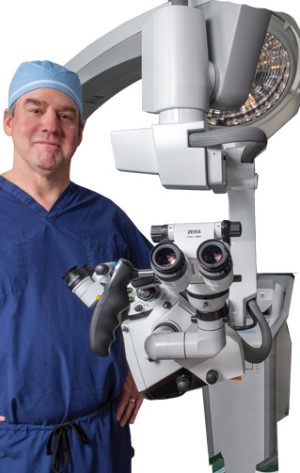At the Gerald J. Glasser Brain Tumor Center, neurosurgeons team up with ear surgeon Jed A. Kwartler, MD, to treat acoustic neuromas – and deliver the best possible outcomes.

Hearing the words, “You have a brain tumor,” is never easy. That’s especially true when you’re diagnosed with a skull base tumor, which are typically some of the most difficult tumors to treat given their hard-to-reach location and proximity to major blood vessels and nerves.
In some cases, tumors – called schwannomas – arise from the cells that surround these cranial nerves. This makes it even more challenging to treat the tumor while preserving the nerves and the functions they control, like sight or facial movement.
Acoustic neuromas, or vestibular schwannomas, which are brain tumors that form on the hearing or balance (vestibular) nerves, fall into this category. When a patient is diagnosed with an acoustic neuroma, there is not only a need to manage the tumor but also preserve their hearing and quality of life.
To provide the most effective care on both fronts, collaboration between a neurosurgeon and a neurotologist, a specialized ear surgeon, is essential. That’s why the highly respected neurosurgeons at the Gerald J. Glasser Brain Tumor Center have been teaming up with Jed A. Kwartler, MD – a neurotologist at Overlook Medical Center and Summit Health – for nearly 20 years.
Determining the Right Path for Each Patient
Acoustic neuromas are benign, slow-growing tumors. Many people may not even know they have an acoustic neuroma, but when symptoms appear, it’s important to get evaluated right away.
“Some of the most common symptoms of acoustic neuromas are sudden hearing loss, a pressure sensation and tinnitus or ringing in just one ear,” explains Dr. Kwartler. “The unilateral nature of these symptoms in particular is a red flag that you need to be seen by a doctor.”

“Warning signs can also include loss of balance and dizziness,” adds Ronald P. Benitez, MD, Chair of Endo-vascular Neurosurgery at Overlook Medical Center and a neurosurgeon with Atlantic NeuroSurgical Specialists. “Depending on the symptoms, patients may be evaluated with a hearing test – which can help identify if the issue is a neurological problem – or an MRI scan, which would reveal if a tumor is in fact present.”
When an acoustic neuroma is identified, there are three options:
- Ongoing monitoring with serial MRIs
- Surgical removal
- Stereotactic radiosurgery, such as CyberKnife
Together, the physicians recommend the best approach to pursue based on a careful examination of several key factors, including:
- Tumor size
- A patient’s age and overall health
For example, if an 85-year-old patient has a relatively small tumor that is not causing any neurological issues, they would typically be monitored with periodic MRIs. On average, acoustic neuromas grow very slowly – about 1 mm per year. Given their advanced age, it’s unlikely that the tumor would have time to grow to the point where it would cause neurological problems.
If it’s a 40-year-old patient with a relatively small acoustic neuroma, they may decide to treat it now before it does become a problem – and more difficult to treat – years down the road.
Regardless of age, timely treatment is required when the tumor is large enough to affect a patient’s hearing or brain functioning.
A More Conservative Approach to Treatment
“Twenty-five years ago, most neurosurgeons were operating on patients with smaller acoustic neuromas. The field has since discovered that many of these patients don’t require traditional brain surgery and may be better suited for stereotactic radiosurgery, such as CyberKnife,” says Dr. Benitez.
CyberKnife radiosurgery is a non-invasive treatment that delivers precise beams of radiation directly to the tumor to stop its growth. This highly targeted approach is ideal for acoustic neuromas that are less than 2 cm in size, small enough to not be pressing up on the brain. Led by Joana S. Emmolo, MD, Director of Radiation Oncology, the Glasser Brain Tumor Center has the largest CyberKnife program in the state of New Jersey.
For some patients, neurosurgery is still the most appropriate treatment option. When it is, the neurosurgeons at the Glasser Brain Tumor Center and Dr. Kwartler work side-by-side in the operating room to meticulously remove the tumor while keeping as much of the cranial nerve intact as possible.
These physicians have extensive experience and expertise in treating acoustic neuromas. Dr. Kwartler also had the privilege of training directly under William House, MD, who pioneered a modern technique for treating these tumors that drastically improves patient outcomes.
In a growing number of cases, a combination of neurosurgery and radiosurgery is best.
“While our goal is always to remove as much of a tumor as possible, we don’t follow the old mentality that a tumor has to be removed in its entirety,” notes Dr. Benitez. “Today the surgical community is more comfortable doing a near-total removal of acoustic neuromas, which helps avoid damage to the brain or cranial nerves. In these cases, we leave a little bit of the tumor behind during surgery and then treat it very precisely with radiosurgery. Combining these modalities often provides the most favorable results.”
“In addition to removing or minimizing the tumor, our goal is to preserve a patient’s hearing,” adds Dr. Kwartler. “However, when that’s not possible, there are new advancements like cochlear implants that can rehabilitate hearing as long as the cochlear nerve is intact. Together, we approach treatment with all of these options in mind to help patients live their best lives.”
Clinical Trials
The Next Generation of Brain Tumor Treatments
At the Glasser Brain Tumor Center, we're extremely proud to have a robust clinical trial research program that is advancing novel brain tumor treatments and offers patients hope. These clinical trials include:
- The "SURVIVE" Phase 2B trial of a first-of-its-kind brain cancer vaccine for patients with newly diagnosed glioblastoma
- A study of Berubicin – one of the first chemotherapy drugs to cross the blood-brain tumor barrier and overcome drug resistance – in adults with recurrent glioblastoma multiforme
- The ongoing development of novel treatments including immunotherapies, brain tumor vaccine strategies, oncolytic tumor viruses and other targeted therapies for high-grade primary brain tumors, low-grade gliomas, metastatic brain tumors and more.